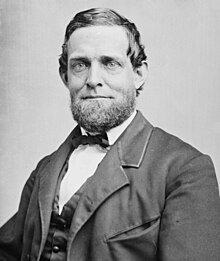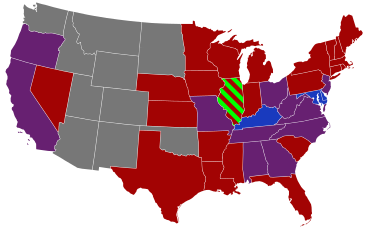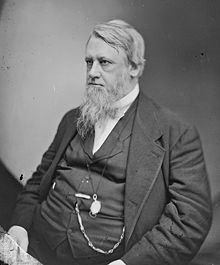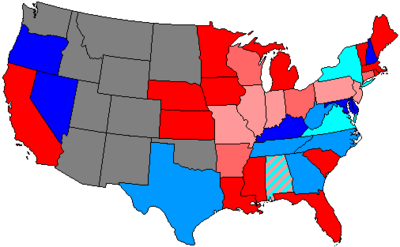Contents
-
(Top)
-
1Major events
-
2Major legislation
-
3Party summary
-
4Leadership
-
5Members
-
5.1Senate
-
5.1.1Alabama
-
5.1.2Arkansas
-
5.1.3California
-
5.1.4Connecticut
-
5.1.5Delaware
-
5.1.6Florida
-
5.1.7Georgia
-
5.1.8Illinois
-
5.1.9Indiana
-
5.1.10Iowa
-
5.1.11Kansas
-
5.1.12Kentucky
-
5.1.13Louisiana
-
5.1.14Maine
-
5.1.15Maryland
-
5.1.16Massachusetts
-
5.1.17Michigan
-
5.1.18Minnesota
-
5.1.19Mississippi
-
5.1.20Missouri
-
5.1.21Nebraska
-
5.1.22Nevada
-
5.1.23New Hampshire
-
5.1.24New Jersey
-
5.1.25New York
-
5.1.26North Carolina
-
5.1.27Ohio
-
5.1.28Oregon
-
5.1.29Pennsylvania
-
5.1.30Rhode Island
-
5.1.31South Carolina
-
5.1.32Tennessee
-
5.1.33Texas
-
5.1.34Vermont
-
5.1.35Virginia
-
5.1.36West Virginia
-
5.1.37Wisconsin
-
-
5.2House of Representatives
-
5.2.1Alabama
-
5.2.2Arkansas
-
5.2.3California
-
5.2.4Connecticut
-
5.2.5Delaware
-
5.2.6Florida
-
5.2.7Georgia
-
5.2.8Illinois
-
5.2.9Indiana
-
5.2.10Iowa
-
5.2.11Kansas
-
5.2.12Kentucky
-
5.2.13Louisiana
-
5.2.14Maine
-
5.2.15Maryland
-
5.2.16Massachusetts
-
5.2.17Michigan
-
5.2.18Minnesota
-
5.2.19Mississippi
-
5.2.20Missouri
-
5.2.21Nebraska
-
5.2.22Nevada
-
5.2.23New Hampshire
-
5.2.24New Jersey
-
5.2.25New York
-
5.2.26North Carolina
-
5.2.27Ohio
-
5.2.28Oregon
-
5.2.29Pennsylvania
-
5.2.30Rhode Island
-
5.2.31South Carolina
-
5.2.32Tennessee
-
5.2.33Texas
-
5.2.34Vermont
-
5.2.35Virginia
-
5.2.36West Virginia
-
5.2.37Wisconsin
-
5.2.38Non-voting members
-
-
-
6Changes in membership
-
7Committees
-
8Caucuses
-
9Employees
-
10See also
-
11Notes
-
12References
-
13External links
The 42nd United States Congress was a meeting of the legislative branch of the United States federal government, consisting of the United States Senate and the United States House of Representatives. It met in Washington, D.C. from March 4, 1871, to March 4, 1873, during the third and fourth years of Ulysses S. Grant's presidency. The apportionment of seats in the House of Representatives was based on the 1860 United States census. Both chambers had a Republican majority.
Major events
- June 10, 1871: U.S. Marines make naval attack on the Han River forts in Korea
- March 1, 1872: Yellowstone National Park was established as the world's first national park
- November 5, 1872: 1872 United States presidential election
Major legislation
- April 20, 1871: Enforcement Act of 1871
- March 1, 1872: Yellowstone National Park founded
- May 10, 1872: General Mining Act of 1872
- May 23, 1872: Amnesty Act of 1872
- June 1, 1872: Practice Conformity Act (precursor to the Rules Enabling Act), ch. 255, 17 Stat. 196
- February 12, 1873: Coinage Act of 1873
- March 3, 1873: Timber Culture Act
- March 3, 1873: Comstock Act
- March 3, 1873: Salary Grab Act (so called)
Party summary
The count below identifies party affiliations at the beginning of the first session of this Congress, and includes members from vacancies and newly admitted states, when they were first seated. Changes resulting from subsequent replacements are shown below in the "Changes in membership" section.
Senate
| Party (shading shows control) |
Total | Vacant | |||
|---|---|---|---|---|---|
| Democratic (D) |
Liberal Republican (LR) | Republican (R) |
|||
| End of previous congress | 12 | 0 | 62 | 74 | 0 |
| Begin | 14 | 1 | 55 | 70 | 4 |
| End | 17 | 54 | 72 | 2 | |
| Final voting share | 23.6% | 1.4% | 75.0% | ||
| Beginning of next congress | 19 | 3 | 50 | 72 | 2 |
House of Representatives
| Party (shading shows control) |
Total | Vacant | |||||
|---|---|---|---|---|---|---|---|
| Democratic (D) |
Independent Republican (IR) | Liberal Republican (LR) | Republican (R) | Other |
|||
| End of previous congress | 67 | 0 | 0 | 169 | 5[a] | 241 | 2 |
| Begin | 102 | 1 | 3 | 135 | 0 | 241 | 2 |
| End | 106 | 4 | 130 | ||||
| Final voting share | 44.0% | 0.4% | 1.7% | 53.9% | 0.0% | ||
| Beginning of next congress | 91 | 0 | 4 | 189 | 6[b] | 290 | 2 |
Leadership

Senate
House of Representatives
Members
This list is arranged by chamber, then by state. Senators are listed in order of seniority, and representatives are listed by district.
Senate
Senators were elected by the state legislatures every two years, with one-third beginning new six-year terms with each Congress. Preceding the names in the list below are Senate class numbers, which indicate the cycle of their election. In this Congress, Class 1 meant their term began in the last Congress, requiring re-election in 1874; Class 2 meant their term began in this Congress, requiring re-election in 1876; and Class 3 meant their term ended in this Congress, requiring re-election in 1872.
House of Representatives
The names of members of the House of Representatives are preceded by their district numbers.
Changes in membership
The count below reflects changes from the beginning of the first session of this Congress.
Senate
- Replacements: 0
- Democratic: no net change
- Republican: no net change
- Deaths: 0
- Resignations: 2
- Contested elections: 0
- Total seats with changes: 4
| State (class) |
Vacated by | Reason for change | Successor | Date of successor's formal installation[c] |
|---|---|---|---|---|
| Virginia (2) | Vacant | Legislature had failed to elect. Previous incumbent re-elected March 15, 1871. |
John W. Johnston (D) | March 15, 1871 |
| Georgia (2) | Vacant | Foster Blodgett presented credentials as Senator-elect, but the Senate declared him not elected. Successor elected November 14, 1871. |
Thomas M. Norwood (D) | November 14, 1871 |
| Mississippi (2) | Vacant | Delayed taking seat in order to serve as Governor of Mississippi | James L. Alcorn (R) | December 1, 1871 |
| North Carolina (2) | Vacant | Legislature had failed to elect. Successor elected January 30, 1872. |
Matt W. Ransom (D) | January 30, 1872 |
| Kentucky (3) | Garrett Davis (D) | Died September 22, 1872. Successor appointed September 27, 1872. Appointee was later elected January 21, 1873, to finish the term.[1] |
Willis B. Machen (D) | September 27, 1872 |
| Louisiana (3) | William P. Kellogg (R) | Resigned November 1, 1872, after being elected Governor of Louisiana | Vacant | Not filled this Congress |
| Massachusetts (2) | Henry Wilson (R) | Resigned March 3, 1873, after being elected U.S. Vice President | Vacant | Not filled this Congress |
House of Representatives
- Replacements: 11
- Democratic: 4 seat net gain
- Republican: 5 seat net loss
- Liberal Republican: 1 seat net gain
- Deaths: 3
- Resignations: 6
- Contested election: 4
- Total seats with changes: 16
| District | Vacated by | Reason for change | Successor | Date of successor's formal installation[c] |
|---|---|---|---|---|
| District of Columbia At-large | New seat | District of Columbia's At-large district created March 4, 1871, and remained vacant until April 21, 1871 | Norton P. Chipman (R) | April 21, 1871 |
| Illinois At-large | Vacant | Rep. John A. Logan resigned at the end of the previous congress after being elected to the US Senate | John L. Beveridge (R) | November 7, 1871 |
| Michigan 4th | Vacant | Rep. Thomas W. Ferry resigned at the end of the previous congress after being elected to the US Senate | Wilder D. Foster (R) | December 4, 1871 |
| Illinois 6th | Burton C. Cook (R) | Resigned August 26, 1871 | Henry Snapp (R) | December 4, 1871 |
| Louisiana 4th | James McCleery (R) | Died November 5, 1871 | Alexander Boarman (LR) | December 3, 1872 |
| Massachusetts 9th | William B. Washburn (R) | Resigned December 5, 1871, after being elected Governor of Massachusetts | Alvah Crocker (R) | January 2, 1872 |
| Arkansas 3rd | John Edwards (LR) | Lost contested election February 9, 1872 | Thomas Boles (R) | February 9, 1872 |
| Massachusetts 7th | George M. Brooks (R) | Resigned May 13, 1872, after becoming judge of probate for Middlesex County | Constantine C. Esty (R) | December 2, 1872 |
| Texas 3rd | William T. Clark (R) | Lost contested election May 13, 1872 | Dewitt C. Giddings (D) | December 13, 1872 |
| Ohio 1st | Aaron F. Perry (R) | Resigned July 14, 1872 | Ozro J. Dodds (D) | October 9, 1872 |
| Georgia 4th | Thomas J. Speer (R) | Died August 18, 1872 | Erasmus W. Beck (D) | December 2, 1872 |
| Connecticut 1st | Julius L. Strong (R) | Died September 7, 1872 | Joseph R. Hawley (R) | December 2, 1872 |
| Pennsylvania 13th | Ulysses Mercur (R) | Resigned December 2, 1872, after becoming an assoc. justice of the Supreme Court of Pennsylvania | Frank C. Bunnell (R) | December 24, 1872 |
| Illinois At-large | John L. Beveridge (R) | Resigned January 4, 1873, after being elected Lieutenant Governor of Illinois | Vacant | Not filled this term |
| South Carolina 2nd | Robert C. De Large (R) | Seat declared vacant January 24, 1873, after election was contested by Christopher C. Bowen | Vacant | Not filled this term |
| Florida At-large | Josiah T. Walls (R) | Lost contested election January 29, 1873 | Silas L. Niblack (D) | January 29, 1873 |
Committees
Lists of committees and their party leaders for members of the House and Senate committees can be found through the Official Congressional Directory at the bottom of this article. The directory after the pages of terms of service lists committees of the Senate, House (Standing with Subcommittees, Select and Special) and Joint and, after that, House/Senate committee assignments. On the committees section of the House and Senate in the Official Congressional Directory, the committee's members on the first row on the left side shows the chairman of the committee and on the right side shows the ranking member of the committee.
Senate
- Agriculture (Chairman: Frederick T. Frelinghuysen; Ranking Member: Henry G. Davis)
- Appropriations (Chairman: Lot M. Morrill; Ranking Member: William Windom)
- Audit and Control the Contingent Expenses of the Senate (Chairman: Matthew H. Carpenter; Ranking Member: Eli Saulsbury)
- Civil Service and Retrenchment (Chairman: George G. Wright; Ranking Member: N/A)
- Claims (Chairman: John Scott; Ranking Member: Arthur I. Boreman)
- Commerce (Chairman: Zachariah Chandler; Ranking Member: William A. Buckingham)
- Distributing Public Revenue Among the States (Select)
- District of Columbia (Chairman: John F. Lewis; Ranking Member: Frederick A. Sawyer)
- Education and Labor (Chairman: James W. Flanagan; Ranking Member: James W. Patterson)
- Engrossed Bills (Chairman: Thomas F. Bayard; Ranking Member: Thomas M. Norwood)
- Finance (Chairman: John Sherman; Ranking Member: Adelbert Ames)
- Foreign Relations (Chairman: Simon Cameron; Ranking Member: Carl Schurz)
- Indian Affairs (Chairman: William A. Buckingham; Ranking Member: Henry Wilson)
- Investigation and Retrenchment (Chairman: William A. Buckingham; Ranking Member; William M. Stewart)
- Judiciary (Chairman: George F. Edmunds; Ranking Member: Frederick T. Frelinghuysen)
- Manufactures (Chairman: Thomas J. Robertson; Ranking Member: Abijah Gilbert)
- Military Affairs (Chairman: John A. Logan; Ranking Member: John A. Logan)
- Mines and Mining (Chairman: Hannibal Hamlin; Ranking Member: Alexander Caldwell)
- Mississippi River Levee System (Select)
- Naval Affairs (Chairman: Aaron H. Cragin; Ranking Member: Thomas W. Ferry)
- Ordnance and War Ships (Select)
- Outrages in Southern States (Select)
- Pacific Railroad (Chairman: William M. Stewart; Ranking Member: William P. Kellogg)
- Patents (Chairman: Orris S. Ferry; Ranking Member: William Windom)
- Pensions (Chairman: Daniel D. Pratt; Ranking Member: Morgan C. Hamilton)
- Post Office and Post Roads (Chairman: Alexander Ramsey; Ranking Member: Hannibal Hamlin)
- Private Land Claims (Chairman: Allen G. Thurman; Ranking Member: Thomas F. Bayard)
- Privileges and Elections (Chairman: Oliver P. Morton; Ranking Member: Joshua Hill)
- Public Buildings and Grounds (Chairman: Justin S. Morrill; Ranking Member: Cornelius Cole)
- Public Lands (Chairman: William Sprague; Ranking Member: William Windom)
- Railroads (Chairman: William M. Stewart; Ranking Member: N/A)
- Removal of Political Disabilities (Select)
- Retrenchment
- Revision of the Laws (Chairman: Hannibal Hamlin; Ranking Member: George G. Wright)
- Revolutionary Claims (Chairman: William G. Brownlow; Ranking Member: Joshua Hill)
- Rules (Select)
- Tariff Regulation (Select)
- Territories (Chairman: Arthur I. Boreman; Ranking Member: Phineas W. Hitchcock)
- Transportation Routes to the Seaboard (Select)
- Whole
House of Representatives
- Accounts (Chairman: James Buffington; Ranking Member: Stevenson Archer)
- Agriculture (Chairman: Charles Hays; Ranking Member: John W. Hazelton)
- Appropriations (Chairman: James A. Garfield; Ranking Member: Eugene Hale)
- Alabama Affairs (Select)
- Arkansas Affairs (Select)
- Banking and Currency (Chairman: Horace Maynard; Ranking Member: Clinton L. Merriam)
- Claims (Chairman: John B. Hawley; Ranking Member: William P. Frye)
- Coinage, Weights and Measures (Chairman: Samuel Hooper; Ranking Member: John Critcher)
- Commerce (Chairman: William A. Wheeler; Ranking Member: James S. Negley)
- District of Columbia (Chairman: Alfred C. Harmer; Ranking Member: Aylett R. Cotton)
- Education and Labor (Chairman: James Monroe; Ranking Member: Robert B. Elliott)
- Elections (Chairman: Horace B. Smith; Ranking Member: Benjamin T. Eames)
- Expenditures in the Interior Department (Chairman: Jackson Orr; Ranking Member: George M. Adams)
- Expenditures in the Justice Department (Chairman: James B. Sener; Ranking Member: N/A)
- Expenditures in the Navy Department (Chairman: Julius C. Burrows; Ranking Member: Benjamin T. Biggs)
- Expenditures in the Post Office Department (Chairman: Henry W. Barry; Ranking Member: William R. Roberts)
- Expenditures in the State Department (Chairman: Jasper Packard; Ranking Member: John Rogers)
- Expenditures in the Treasury Department (Chairman: J. Hale Sypher; Ranking Member: William H. Barnum)
- Expenditures in the War Department (Chairman: William Williams; Ranking Member: Ephraim L. Acker)
- Expenditures on Public Buildings (Chairman: R. Holland Duell; Ranking Member: Fernando Wood)
- Freedmen's Affairs (Chairman: Clinton L. Cobb; Ranking Member: Joseph H. Rainey)
- Foreign Affairs (Chairman: Godlove Stein Orth; Ranking Member: Jasper Packard)
- Indian Affairs (Chairman: John T. Averill; Ranking Member: John C. Edwards)
- Invalid Pensions (Chairman: Jeremiah McLain Rusk; Ranking Member: Benjamin S. Turner)
- Judiciary (Chairman: Benjamin F. Butler; Ranking Member: Milo Goodrich)
- Manufactures (Chairman: Charles B. Farwell; Ranking Member: John M. Rice)
- Mileage (Chairman: Hezekiah S. Bundy; Ranking Member: Edward I. Golladay)
- Military Affairs (Chairman: John Coburn; Ranking Member: George E. Harris)
- Militia (Chairman: Roderick R. Butler; Ranking Member: John C. Conner)
- Mines and Mining (Chairman: David P. Lowe; Ranking Member: Walter L. Sessions)
- Naval Affairs (Chairman: Glenni W. Scofield; Ranking Member: John M. Coghlan)
- Pacific Railroads (Chairman: Philetus Sawyer; Ranking Member: John T. Averill)
- Patents (Chairman: Omar D. Conger; Ranking Member: Joseph M. Warren)
- Post Office and Post Roads (Chairman: John B. Packer; Ranking Member: Charles H. Porter)
- Private Land Claims (Chairman: Jasper Packard; Ranking Member: J. Allen Barber)
- Public Buildings and Grounds (Chairman: James H. Platt Jr.; Ranking Member: Walter L. Sessions)
- Public Expenditures (Chairman: Harrison E. Havens; Ranking Member: Thomas Kinsella)
- Public Lands (Chairman: Washington Townsend; Ranking Member: Jeremiah M. Rusk)
- Railways and Canals (Chairman: George W. McCrary; Ranking Member: Charles St. John
- Reform on Civil Service (Chairman: Stephen W. Kellogg; Ranking Member: N/A)
- Revision of Laws (Chairman: Luke P. Poland; Ranking Member: John S. Bigby)
- Revolution Claims (Chairman: Alexander S. Wallace; Ranking Member: Abram Comingo)
- Revolutionary Pensions and War of 1812 (Chairman: Lazarus D. Shoemaker; Ranking Member: John M. Rice)
- Rules (Select) (Chairman: James G. Blaine; Ranking Member: Samuel S. Cox)
- Standards of Official Conduct
- Territories (Chairman: George C. McKee; Ranking Member: Lazarus D. Shoemaker)
- War Claims (Chairman: William Lawrence; Ranking Member: N/A)
- Ways and Means (Chairman: Henry L. Dawes; Ranking Member: Horatio C. Burchard)
- Whole
Joint committees
- Conditions of Indian Tribes (Special)
- Enrolled Bills (Chairman: Rep. Chester B. Darrall; Vice Chairman: Rep. John T. Bird)
- Inquire into the Affairs of the District of Columbia (Select) (Chairman: Rep. Jeremiah M. Wilson; Vice Chairman: N/A)
- The Library (Chairman: Rep. William P. Frye; Vice Chairman: Rep. Lewis D. Campbell)
- Printing (Chairman: Rep. William G. Donnan; Vice Chairman: Rep. William P. Price)
Caucuses
- Democratic (House)
- Democratic (Senate)
Employees
Legislative branch agency directors
Senate
- Chaplain: John P. Newman (Methodist)
- Librarian: George S. Wagner, from 1871
- Secretary: George C. Gorham
- Sergeant at Arms: John R. French
House of Representatives
- Chaplain: John G. Butler (Presbyterian)
- Clerk: Edward McPherson
- Clerk at the Speaker's Table: John M. Barclay
- Doorkeeper: Otis S. Buxton
- Postmaster: William S. King
- Reading Clerks: Charles N. Clisbee (D) and William K. Mehaffey (R)
- Sergeant at Arms: Nehemiah G. Ordway
See also
- 1870 United States elections (elections leading to this Congress)
- 1972 United States elections (elections during this Congress, leading to the next Congress)
Notes
- ^ Conservative
- ^ Independent Democratic
- ^ a b When seated or oath administered, not necessarily when service began.
References
- ^ Byrd & Wolff, p. 112.
- Byrd, Robert C.; Wolff, Wendy (October 1, 1993). The Senate, 1789-1989: Historical Statistics, 1789-1992 (volume 4 Bicentennial ed.). U.S. Government Printing Office. ISBN 9780160632563.
- Martis, Kenneth C. (1989). The Historical Atlas of Political Parties in the United States Congress. New York: Macmillan Publishing Company.
- Martis, Kenneth C. (1982). The Historical Atlas of United States Congressional Districts. New York: Macmillan Publishing Company.
External links
- Statutes at Large, 1789-1875
- Senate Journal, First Forty-three Sessions of Congress
- House Journal, First Forty-three Sessions of Congress
- Biographical Directory of the U.S. Congress
- U.S. House of Representatives: House History
- U.S. Senate: Statistics and Lists
- Congressional Directory for the 42nd Congress, 1st Session.
- Congressional Directory for the 42nd Congress, 2nd Session.
- Congressional Directory for the 42nd Congress, 2nd Session (Revision).
- Congressional Directory for the 42nd Congress, 3rd Session.
- Congressional Directory for the 42nd Congress, 3rd Session (Revision).





